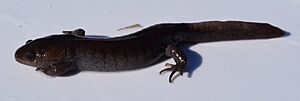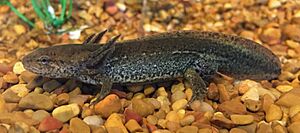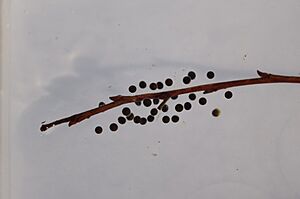Mole salamander facts for kids
Quick facts for kids Mole salamander |
|
|---|---|
 |
|
| Conservation status | |
| Scientific classification | |
| Genus: |
Ambystoma
|
| Species: |
talpoideum
|
| Synonyms | |
|
Salamandra talpoidea |
|
The mole salamander (scientific name: Ambystoma talpoideum) is a type of salamander found in many parts of the eastern and central United States. You can find them from Florida all the way to Texas, and north to Illinois. Sometimes, people call them "tadpole salamanders." This is because some mole salamanders stay in a special "neotenic" state. This means they keep their gills and live in water, even as adults. These salamanders usually live on the forest floor, hiding under leaves. They move to ponds when it's time to breed.
Contents
What Do Mole Salamanders Look Like?
Mole salamanders are quite chunky. They have short bodies and big heads. Their length can be from about 4.5 to 10.9 centimeters (1.8 to 4.3 inches). They usually weigh between 3.5 and 10.5 grams.
Their skin is often gray or dark brown. They have darker spots and lighter gray undersides. Male salamanders can be identified by a swollen area called a cloaca. Young salamanders and adults that stay in the water have large, feathery gills. You can tell A. talpoideum larvae apart from other salamander larvae. They have two light stripes on their underside.
Where Do Mole Salamanders Live?
Mole salamanders live in the lowlands of the southeastern United States. Their main home stretches from eastern Texas to southern South Carolina. They can be found inland as far as southern Illinois.
They are not found in southern Florida or Louisiana. There are also separate groups in Kentucky, Virginia, and Tennessee. You can find them in North Carolina, northern South Carolina, northern Georgia, and northern Alabama too. A small group also lives in the very southern part of Indiana.
Their Favorite Places
These salamanders like pine or broadleaf forests that flood sometimes. They especially like areas near gum and cypress ponds. Adult mole salamanders live under leaves on the forest floor. Young salamanders live in ponds and temporary waters that don't have fish.
Adults need safe places to hide. These can be burrows, logs, or cracks. These spots help them stay safe, control their body temperature, and avoid drying out.
How Mole Salamanders Reproduce
Mole salamanders breed between October and March. They choose ponds that stay wet for a while. These ponds must have good areas around them for burrowing and finding food. If there are many male salamanders in one area, other males might be less likely to mate.
Mole Salamander Behavior
Mole salamanders are mostly active at night. You can find them in moist forest areas. They usually stay close to a steady water source. Adult salamanders move up to 160 meters (about 525 feet) to reach water. They do this on rainy winter nights when it's time to breed.
Eggs and Young Salamanders
The eggs are laid in the spring, often during heavy rains. Some young salamanders change completely into adults. This process is called metamorphosis. Others stay in a "neotenic" state. This means they keep their gills and live in the water, even as adults.
If a pond has fish that eat salamanders, like the bluegill, more young salamanders will go through metamorphosis. They change into land-dwelling adults to escape the fish. If ponds dry out, more salamanders also change. But if ponds stay wet, they tend to remain in their water-living, neotenic form.
Defense and Diet
When attacked, adult and young mole salamanders lower their heads. This shows off special glands on their necks. These glands release a bad-tasting liquid to scare away predators.
Mole salamanders eat almost anything smaller than themselves. This includes different kinds of insects and even tadpoles. Their diet is mostly made up of various arthropods (like insects and spiders). They eat only a small number of other salamander larvae.
Conservation Status
The IUCN (International Union for Conservation of Nature) lists the mole salamander as "Least Concern". This means their population is stable and not in danger.
However, there are still threats to these salamanders. These include:
- Forest ponds and swamp habitats being destroyed.
- Breeding ponds being filled in or made too deep.
- New types of fish that eat salamanders being put into their ponds.
In Indiana, the mole salamander is listed as an endangered species. This means they are at high risk of disappearing from that state.
See also
 In Spanish: Ambystoma para niños
In Spanish: Ambystoma para niños




